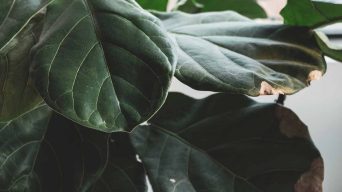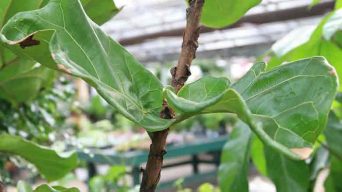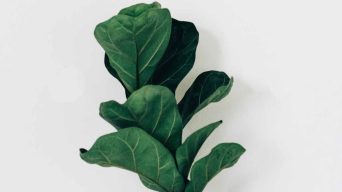A fiddle leaf fig that is not getting enough water may have brown spots on its leaves, wilted or curled leaves, and burnt leaf tips. Check the soil moisture and make sure the pot has proper drainage to prevent root rot. Give your fiddle leaf fig a thorough watering and monitor the soil moisture going forward
The gorgeous Fiddle Leaf Fig (Ficus lyrata) is a stunning houseplant that stands out with its bold, luxuriant leaves. Admired for its beauty and resilience, this species of fig tree has become an increasingly popular choice for indoor plant lovers.
Though they are generally easy to care for, they may suffer from a variety of issues – brown leaves, wilting, and yellowing being the most common.
One of the major causes of these problems is underwatering.
Knowing how to identify an underwatered Fiddle Leaf Fig, as well as its treatments and prevention methods, is key to maintaining a healthy houseplant.
Why Is Underwatering A Problem?
Water is essential to the health of Fiddle Leaf Fig plants; however, many people are hesitant to water their plants, out of fear that they will overwater them and cause root rot.
While overwatering Fiddle Leaf Fig plants can certainly be detrimental, underwatering can be just as harmful. Without adequate water, plants may suffer in a variety of ways.
Wilting leaves, yellowing or browning foliage, stunted growth, and even death could all result from a lack of water.
How Does Underwatering a Fiddle Leaf Fig Occur
Underwatering Fiddle Leaf Fig plants is a common problem, and there are several ways this can happen. The most common causes of underwatering are:
Inadequate Watering Schedule
Watering your Fiddle Leaf Fig tree is essential in order to keep it healthy and thriving, especially during its active growth period from spring to summer.
Depending on the size of the plant and pot, your Fiddle Leaf Fig may need to be watered as frequently as once a week or even more.
If you are unsure if your plant needs watering, check the top inch or so of soil – if it is dry, it’s time to water.
Improper Drainage
The roots of Fiddle Leaf Fig plants need well-draining potting soil in order to avoid sitting in water, which can lead to root rot.
If your plant’s pot doesn’t have proper drainage and the water can’t be drained away, the roots sit in the water and cannot take up the moisture they need. This can result in underwatering and a range of negative side effects for the plant.
To create an environment that allows for better drainage, consider transplanting your Fiddle Leaf Fig into a new pot with fresh, high-quality potting soil mix.
Be sure to select a mix that is specifically designed for potted plants, as it will be more suitable for transporting excess water away from the plant’s roots.
Adding a layer of pebbles to the bottom of your new pot is also recommended, as this will help promote greater aeration and allow any excess water to drain away more quickly.
Not Enough Humidity
Fiddle Leaf Figs are especially fond of high humidity levels, as this allows them to absorb moisture in a more efficient manner.
For those with a dry home environment, the plant can suffer from water loss at a faster rate than normal. In order to increase the air’s moisture content and provide relief to the plant, there are several easy solutions you can implement.
One of the simplest approaches is using a humidifier, which will steadily raise the humidity levels in your living space.
Alternatively, misting the leaves with water or placing the pot on top of a pebble tray is also an effective solution for increasing humidity around your Fiddle Leaf Fig.
A pebble tray consists of rocks and water that work together to generate more moisture within its vicinity, creating a more suitable atmosphere for your plant.
Hot, Dry Weather
Aside from proper watering techniques, there are other ways to help keep your Fiddle Leaf Fig well hydrated even in areas with hot and dry climates.
Placing plants near windows or other sources of indirect sunlight will help them absorb more of the sun’s warmth and alleviate some of the stress caused by hotter temperatures.
It also helps them receive adequate light for photosynthesis which will further aid them in retaining moisture within their leaves and stems.
Too Much Sunlight
Fiddle Leaf Figs require bright indirect light to thrive.
Too much direct sunlight can lead to the plant’s leaves taking in more water than they can use, resulting in an excessive amount of water loss through evaporation.
In order to avoid this, it may be necessary to move the plant to a spot with less sun. If this is not possible, one way of providing some shade for the plant is by hanging a sheer curtain or placing the pot on a tray filled with pebbles and water.
Doing so will help ensure that the Fiddle Leaf Fig has its essential needs met without over-exposure to direct sunlight.
Poor Root System
Fiddle Leaf Fig plants require a strong, healthy root system in order to uptake water properly and thrive. If this is lacking, the plant will begin to suffer and struggle.
There are several factors that can contribute to the roots of a Fiddle Leaf Fig plant being damaged or weakened.
These include overwatering or underwatering, becoming rootbound in the same pot for too long, and diseases or pests.
Fortunately, there are effective steps one can take to help their plant recover. The most successful way is often transplanting the Fiddle Leaf Fig into a new pot with fresh soil that has proper drainage.
By doing this, the roots have an opportunity to heal and start taking up water again as they would normally.
How To Tell If Your Fiddle Leaf Fig Is Underwatered
Watering your plants is an essential part of keeping them healthy and happy, yet it can be easy to unintentionally underwater them.
To ensure that your plants remain in good health and avoid irreparable damage, it’s key to recognize the common signs of underwatering before it’s too late.
Signs of an Underwatered Fiddle Leaf Fig
If you’re wanting to know if your Fiddle Leaf Fig is getting too much water, there are a few tell-tale signs that can help you. Look for the following indicators:
Drooping Leaves
When Fiddle Leaf Fig leaves start to droop, it is a clear indication that the plant is not receiving enough water. This lack of water means that the plant does not have enough energy to sustain its leaves, causing them to droop.
If the leaves are only slightly sagging and wilting, more frequent watering should be done.
On the other hand, if the leaves are severely wilted and drooped, it is a sign that the plant is already under drought stress and requires immediate watering.
Yellow Leaves
The leaves of your Fiddle Leaf Fig may start to turn yellow, a visible indication that the plant is not receiving enough water.
When plants do not get an adequate amount of water, they cannot transport vital nutrients to their leaves leading to the yellowing of foliage. This is an obvious sign that the plant is under drought stress and must be watered immediately.
Brown Spots on Leaves
If your Fiddle Leaf Fig is displaying brown spots, it is an indication that the plant is not receiving the adequate amount of water.
The lack of water affects its ability to transport necessary nutrients to its leaves, resulting in the wilting, drying and turning of the foliage to a brown hue.
When this occurs, it means that the plant is already going through drought stress, and requires water immediately.
Wilting Leaves
Wilting leaves on your Fiddle Leaf Fig are an indication that the plant is not receiving enough water.
When plants don’t have adequate hydration, they lose moisture faster than they can absorb it, resulting in wilting.
To determine if the plants need water, check the soil by feeling it with your hands; if it’s dry, water the plant immediately.
Curling Leaves
When the leaves of your Fiddle Leaf Fig start to curl, it’s an indication that the plant is not receiving enough water.
This happens when plants are unable to absorb sufficient moisture due to dehydration and begin to lose moisture faster than they can take it in.
Curling leaves are a sign of distress for the plant, as it is already suffering from drought stress and needs immediate hydration.
Brown Leaf Tips or Edges
Plants rely on water to survive, and your Fiddle Leaf Fig is no exception.
When it doesn’t get enough water, the leaves can become dry and start to brown at the tips or edges. This is known as desiccation, and it’s an early warning sign that your plant needs more frequent watering.
To help ensure your Fiddle Leaf Fig stays healthy, you should make sure you are providing adequate hydration.
Dry or Cracked Soil
Water is essential for the health of your Fiddle Leaf Fig, and a lack of it can result in some obvious signs.
If you notice the soil drying out or cracking, this is an indication that your plant isn’t receiving adequate water. As the soil dries out further, it may start to pull away from the sides of the pot.
There may also be some crumbling or flaking when touched. All these are clear indicators that your beloved Fiddle Leaf Fig needs to be watered soon.
Leaf Drop
When it comes to your beloved Fiddle Leaf Fig, one of the most telling signs that it is not receiving enough water is when its leaves start to fall off.
This usually occurs because a lack of water means the plant can no longer support the weight of its foliage and must shed them in order to become more efficient.
If you notice this happening, it is paramount that you take immediate action to provide your plant with hydration again.
Slow Growth
When Fiddle Leaf Figs don’t show signs of growth, it’s a clear indication that they aren’t getting enough water.
Without access to a sufficient amount of water, the plants are unable to transport the essential nutrients and minerals needed for them to continue growing.
If your Fiddle Leaf Fig has slowed its growth rate, it’s an obvious sign that the plant is being underwatered and needs more frequent watering sessions.
How To Save an Underwatered Fiddle Leaf Fig
Watering your Fiddle Leaf Fig is essential for its health and growth, so if you find that your plant is underwatered, there are a few things you can do to save it. Here are some tips:
Water Deeply and Thoroughly
When it comes to providing your plant with water, be sure to not just give it a quick sprinkle. Instead, you should ensure that you provide a thorough, deep watering.
Take the time to saturate the soil so that the water is coming out of the drainage holes at the bottom of the pot. This will help guarantee that your plant’s roots are absorbing the necessary water.
Give the Plant Time to Dry Out
Checking the soil is the best way to easily gauge when your plant needs to be watered. To do this, stick your finger into the soil up to the first knuckle and feel for moisture.
If the soil feels dry and lacks any dampness, it’s time to give your plant some water. However, if you can feel that the soil is still wet, wait for it to dry out before giving your plant more water.
Soak the Plant’s Roots
Watering a really dry plant can be done by immersing the entire pot in a sink or basin filled with water. Allow it to soak for approximately 30 minutes, so that the water can reach deep down into the roots of the plant.
Once this time has passed, carefully remove the pot from the sink, draining any excess water before returning the plant to its planter. Doing this helps ensure that the roots are receiving enough hydration.
Use a Humidity Tray
Placing a humidity tray under the plant pot can help to increase the moisture level in the air surrounding your houseplants.
This beneficial effect is caused by the process of evaporation; as water evaporates, it releases moisture into the air, which in turn allows plants to take up water more readily.
To achieve this, you simply need to fill a tray with water and place it beneath your plant pot.
Mist the Plant
Misting the plant regularly with water can help to increase the humidity in its immediate environment, allowing it to absorb moisture more efficiently.
Not only will this help to keep the air around the plant moist, but it can also aid in preventing wilting and yellowing of leaves due to dryness.
For optimal results, consider using a spray bottle to mist the plant every day or two.
Move the Plant to a Cooler Location
Moving a plant to a cool location, such as a room with an air temperature lower than the one it came from, can help boost its ability to take up water.
This is because when the air around is too warm, it can make it harder for the plant to complete this process.
The cooler environment will provide more favorable conditions and allow it to absorb hydration more efficiently.
Increase the Humidity in Your Home
Adding humidity to the air in your home can help plants absorb water more easily.
To increase the moisture content, you can employ a humidifier or place a bowl of water nearby the plant.
As the liquid evaporates, it will boost the level of moisture around the greenery, making it easier for them to take water into their system.
Use the Right Size Pot
Using a pot that’s too small can hinder a plant’s ability to take up water, resulting in dehydration.
To remedy this issue, it is strongly recommended to use a pot with a diameter 2-3 inches larger than the current one.
This helps create space for more water to be taken up by the root system of the plant and ensures that dehydration is avoided.
Check the Drainage Holes
Plants need to take up water in order to survive, but if the drainage holes in the pot are blocked, this can make it difficult.
To prevent this from becoming an issue, unblocking these holes with a paperclip or toothpick is necessary. This will ensure that the plant can effectively absorb the water it needs for growth and health.
Taking a few moments to identify and clear any blockages in the drainage holes of your pot can make a difference for your plant’s overall well-being.
Use the Right Soil
Using the right type of soil is essential for a plant’s ability to absorb moisture.
A well-draining potting mix can make all the difference, as it optimizes the hydration process and makes it much easier for the roots to take up water from the soil.
This ensures that the plant can access and use water more efficiently, allowing it to reach its full potential in terms of growth and health.
In addition to improving moisture absorption, using a well-draining potting mix also helps with aeration by ensuring that there are plenty of small open spaces between particles for air and oxygen to pass through.
Be Patient
Watering a plant too little can cause it to suffer from dehydration and become unhealthy.
However, if the proper care is taken, it is possible for the plant to recover. Doing so takes patience and dedication, as it may take some time for the plant to regain its former health.
How To Prevent Underwatering a Fiddle Leaf Fig
Watering your Fiddle Leaf Fig incorrectly is one of the most frequent mistakes made by plant owners. This tropical African plant thrives in hot, humid environments and is sensitive to changes in water availability.
When deprived of the right amount of moisture, a Fiddle Leaf Fig will respond by shedding its leaves.
To ensure that your beloved plant gets ample hydration, here are some helpful tips to prevent underwatering your Fiddle Leaf Fig:
- Checking the soil regularly and watering when the top inch of soil is dry is essential for proper plant care.
- Using a moisture meter can help accurately gauge when to water your plants, as well as providing additional information about their needs.
- To avoid overwatering, make sure the pot has drainage holes so that any excess liquid can be removed from the pot and not sit in stagnant water.
- If you plan to go on vacation, find someone reliable to water your plants while you are away, or consider getting a self-watering pot for added convenience.
- During winter months when plants are dormant, it’s important to reduce the amount of water given to them in order to keep them healthy.
- Keeping plants out of direct sunlight will help preserve moisture in their soil; they should only receive indirect sunlight instead.
- If your home tends to have dry air, use a humidifier nearby to increase humidity around your plants and mist their leaves with water every few days if possible.
- Placing multiple plants together can also create a mini-greenhouse effect which further increases humidity levels and creates an ideal environment for your greenery.
Final Thoughts
When caring for a fiddle leaf fig, it is essential to stay proactive when it comes to watering.
Too little water can lead to an underwatered state and the plant’s health may suffer as a result.
To avoid this, ensure that only the top inch of soil is dry before watering, as too much water can also be detrimental.
With a little attention and care, your fiddle leaf fig will thrive for years.







